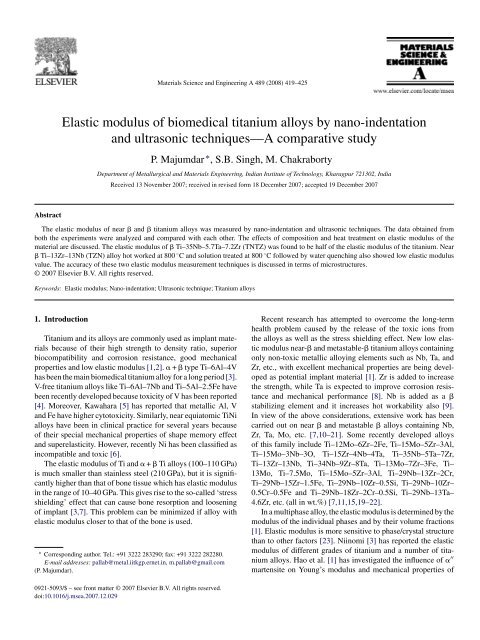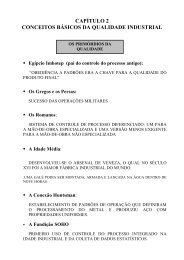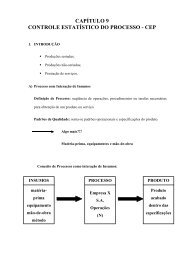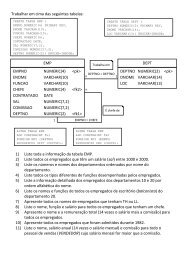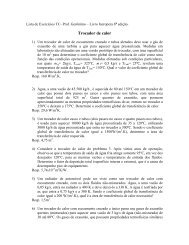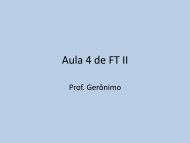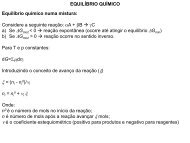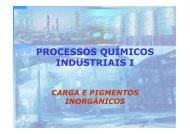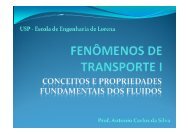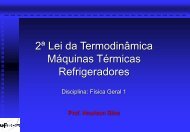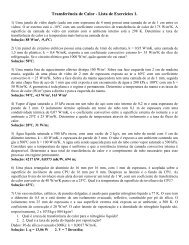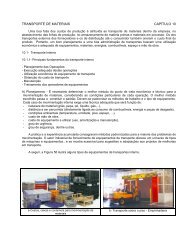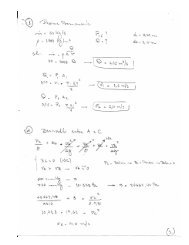Elastic modulus of biomedical titanium alloys by nano ... - Sistemas
Elastic modulus of biomedical titanium alloys by nano ... - Sistemas
Elastic modulus of biomedical titanium alloys by nano ... - Sistemas
Create successful ePaper yourself
Turn your PDF publications into a flip-book with our unique Google optimized e-Paper software.
Materials Science and Engineering A 489 (2008) 419–425<strong>Elastic</strong> <strong>modulus</strong> <strong>of</strong> <strong>biomedical</strong> <strong>titanium</strong> <strong>alloys</strong> <strong>by</strong> <strong>nano</strong>-indentationand ultrasonic techniques—A comparative studyP. Majumdar ∗ , S.B. Singh, M. ChakrabortyDepartment <strong>of</strong> Metallurgical and Materials Engineering, Indian Institute <strong>of</strong> Technology, Kharagpur 721302, IndiaReceived 13 November 2007; received in revised form 18 December 2007; accepted 19 December 2007AbstractThe elastic <strong>modulus</strong> <strong>of</strong> near and <strong>titanium</strong> <strong>alloys</strong> was measured <strong>by</strong> <strong>nano</strong>-indentation and ultrasonic techniques. The data obtained fromboth the experiments were analyzed and compared with each other. The effects <strong>of</strong> composition and heat treatment on elastic <strong>modulus</strong> <strong>of</strong> thematerial are discussed. The elastic <strong>modulus</strong> <strong>of</strong> Ti–35Nb–5.7Ta–7.2Zr (TNTZ) was found to be half <strong>of</strong> the elastic <strong>modulus</strong> <strong>of</strong> the <strong>titanium</strong>. Near Ti–13Zr–13Nb (TZN) alloy hot worked at 800 ◦ C and solution treated at 800 ◦ C followed <strong>by</strong> water quenching also showed low elastic <strong>modulus</strong>value. The accuracy <strong>of</strong> these two elastic <strong>modulus</strong> measurement techniques is discussed in terms <strong>of</strong> microstructures.© 2007 Elsevier B.V. All rights reserved.Keywords: <strong>Elastic</strong> <strong>modulus</strong>; Nano-indentation; Ultrasonic technique; Titanium <strong>alloys</strong>1. IntroductionTitanium and its <strong>alloys</strong> are commonly used as implant materialsbecause <strong>of</strong> their high strength to density ratio, superiorbiocompatibility and corrosion resistance, good mechanicalproperties and low elastic <strong>modulus</strong> [1,2]. + type Ti–6Al–4Vhas been the main <strong>biomedical</strong> <strong>titanium</strong> alloy for a long period [3].V-free <strong>titanium</strong> <strong>alloys</strong> like Ti–6Al–7Nb and Ti–5Al–2.5Fe havebeen recently developed because toxicity <strong>of</strong> V has been reported[4]. Moreover, Kawahara [5] has reported that metallic Al, Vand Fe have higher cytotoxicity. Similarly, near equiatomic TiNi<strong>alloys</strong> have been in clinical practice for several years because<strong>of</strong> their special mechanical properties <strong>of</strong> shape memory effectand superelasticity. However, recently Ni has been classified asincompatible and toxic [6].The elastic <strong>modulus</strong> <strong>of</strong> Ti and + Ti <strong>alloys</strong> (100–110 GPa)is much smaller than stainless steel (210 GPa), but it is significantlyhigher than that <strong>of</strong> bone tissue which has elastic <strong>modulus</strong>in the range <strong>of</strong> 10–40 GPa. This gives rise to the so-called ‘stressshielding’ effect that can cause bone resorption and loosening<strong>of</strong> implant [3,7]. This problem can be minimized if alloy withelastic <strong>modulus</strong> closer to that <strong>of</strong> the bone is used.∗ Corresponding author. Tel.: +91 3222 283290; fax: +91 3222 282280.E-mail addresses: pallab@metal.iitkgp.ernet.in, m.pallab@gmail.com(P. Majumdar).Recent research has attempted to overcome the long-termhealth problem caused <strong>by</strong> the release <strong>of</strong> the toxic ions fromthe <strong>alloys</strong> as well as the stress shielding effect. New low elastic<strong>modulus</strong> near- and metastable- <strong>titanium</strong> <strong>alloys</strong> containingonly non-toxic metallic alloying elements such as Nb, Ta, andZr, etc., with excellent mechanical properties are being developedas potential implant material [1]. Zr is added to increasethe strength, while Ta is expected to improve corrosion resistanceand mechanical performance [8]. Nb is added as a stabilizing element and it increases hot workability also [9].In view <strong>of</strong> the above considerations, extensive work has beencarried out on near and metastable <strong>alloys</strong> containing Nb,Zr, Ta, Mo, etc. [7,10–21]. Some recently developed <strong>alloys</strong><strong>of</strong> this family include Ti–12Mo–6Zr–2Fe, Ti–15Mo–5Zr–3Al,Ti–15Mo–3Nb–3O, Ti–15Zr–4Nb–4Ta, Ti–35Nb–5Ta–7Zr,Ti–13Zr–13Nb, Ti–34Nb–9Zr–8Ta, Ti–13Mo–7Zr–3Fe, Ti–13Mo, Ti–7.5Mo, Ti–15Mo–5Zr–3Al, Ti–29Nb–13Zr–2Cr,Ti–29Nb–15Zr–1.5Fe, Ti–29Nb–10Zr–0.5Si, Ti–29Nb–10Zr–0.5Cr–0.5Fe and Ti–29Nb–18Zr–2Cr–0.5Si, Ti–29Nb–13Ta–4.6Zr, etc. (all in wt.%) [7,11,15,19–22].In a multiphase alloy, the elastic <strong>modulus</strong> is determined <strong>by</strong> the<strong>modulus</strong> <strong>of</strong> the individual phases and <strong>by</strong> their volume fractions[1]. <strong>Elastic</strong> <strong>modulus</strong> is more sensitive to phase/crystal structurethan to other factors [23]. Niinomi [3] has reported the elastic<strong>modulus</strong> <strong>of</strong> different grades <strong>of</strong> <strong>titanium</strong> and a number <strong>of</strong> <strong>titanium</strong><strong>alloys</strong>. Hao et al. [1] has investigated the influence <strong>of</strong> ′′martensite on Young’s <strong>modulus</strong> and mechanical properties <strong>of</strong>0921-5093/$ – see front matter © 2007 Elsevier B.V. All rights reserved.doi:10.1016/j.msea.2007.12.029
420 P. Majumdar et al. / Materials Science and Engineering A 489 (2008) 419–425forged Ti–29Nb–13Ta–4.6Zr (wt.%) alloy and concluded thatthe Young’s <strong>modulus</strong> <strong>of</strong> ′′ martensite is comparable with phase. Saito et al. [24] have reported that cold working substantiallydecreases the elastic <strong>modulus</strong> and increases the yieldstrength <strong>of</strong> Ti–23Nb–0.7Ta–2Zr–O alloy, though the reasons forthis decrease in the elastic <strong>modulus</strong> has not been discussed indetail. Munuera et al. [25] have investigated the <strong>nano</strong>scale surfaceelasticity <strong>of</strong> three different <strong>titanium</strong> <strong>alloys</strong> (Ti–7Nb–6Al,Ti–13Zr–13Nb and Ti–15Zr–4Nb) in their as received state andafter oxidation treatment using force microscopy mode in scanningforce microscopy and reported that the Young’s <strong>modulus</strong> <strong>of</strong>the sample surface was below 65 GPa and was as low as 20 GPafor some oxidized samples. The values were related to the ratio<strong>of</strong> the amount <strong>of</strong> and phases in the as received samples aswell as to different chemical composition <strong>of</strong> the outer layersobtained after different oxidation treatment.With the above background in mind, present investigationwas undertaken to prepare and characterize ‘near ’ and‘metastable ’ <strong>titanium</strong> <strong>alloys</strong> with no toxic alloying elements.Particular emphasis was laid on measuring the elastic <strong>modulus</strong><strong>of</strong> the <strong>alloys</strong> and correlate it with the microstructure. The elastic<strong>modulus</strong> <strong>of</strong> the <strong>alloys</strong> was measured <strong>by</strong> ultrasonic method as wellas <strong>by</strong> <strong>nano</strong>-indentation technique and the values obtained fromthese two techniques are compared in the light <strong>of</strong> microstructuralvariations. In addition, the elastic <strong>modulus</strong> <strong>of</strong> cp-Ti wasalso measured for comparison <strong>of</strong> the elastic <strong>modulus</strong> <strong>of</strong> variousphases. Cp-Ti is expected to show a homogenous microstructureand therefore it was also used as a ‘standard’ material to examinethe effectiveness <strong>of</strong> <strong>nano</strong>-indentation technique to measurethe elastic <strong>modulus</strong>.1.1. Measurement <strong>of</strong> <strong>modulus</strong> <strong>of</strong> elasticityYoung’s Modulus <strong>of</strong> <strong>Elastic</strong>ity is defined as the ratio <strong>of</strong> stress(force per unit area) to corresponding strain (deformation) in theelastic region <strong>of</strong> deformation <strong>of</strong> a material loaded under tensionor compression. This basic material property is <strong>of</strong> interest inmany manufacturing and research applications and is relatedto the atomic bonding <strong>of</strong> the materials. In case <strong>of</strong> biomaterialsfor load bearing applications, the elastic <strong>modulus</strong> is an importantparameter. The stiffness mismatch between implant material andsurrounding bone leads to ‘stress shielding’ <strong>of</strong> the bone. Higherstiffness or Young <strong>modulus</strong> <strong>of</strong> the implant will result in a greateramount <strong>of</strong> bone loss, bone fracture and loss <strong>of</strong> bone interface.Also, loss <strong>of</strong> bone due to stress shielding effects makes revisionsurgeries more difficult. Finite element analysis has suggestedthat a low elastic <strong>modulus</strong> hip prosthesis can stimulate betterbone growth <strong>by</strong> distributing the stress to the adjacent bone tissue[26–29]. The elastic <strong>modulus</strong> <strong>of</strong> the materials can be determined<strong>by</strong> different methods, such as ultrasonic and <strong>nano</strong>-indentationtechniques.Nano-indentation is a technique for determining both theelastic and plastic properties <strong>of</strong> the materials at a <strong>nano</strong>scale levelin a single experiment where no special sample preparation isrequired (however, a good surface finish is needed). In <strong>nano</strong>indentation,the indentation process is continuously monitoredwith respect to force, displacement and time. The reduced elastic<strong>modulus</strong>, E r , is defined as [30,31]:√ π 1E r = √ (1.1)2C Acwhere A c is the projected contact area and C is the contact compliancebetween the indenter and the sample, equal to the tangentto the force–displacement curve during unloading at maximumload F max after correction for frame compliance:C = C t − C f = dh(1.2)dFwhere C t is the total compliance, C f the frame compliance, Fthe force and h is the displacement.Finally,1E r= 1 − υ2 sE s+ 1 − υ2 iE i(1.3)where υ s and υ i , E s and E i are Poisson’s ratios and elastic moduli<strong>of</strong> the sample and indenter, respectively.Velocity <strong>of</strong> the ultrasonic waves in a solid medium is directlyrelated to the elastic properties and density <strong>of</strong> the material. Theelasticity <strong>of</strong> the material delays the transmission <strong>of</strong> wave andintroduces a time delay, i.e. a phase lag. When the frequency<strong>of</strong> the wave is higher than the audible range, it is called elasticwave or ultrasound. Two types <strong>of</strong> vibration-induced deformationresulting in compression or shear are generally possible in aninfinite medium. These are associated with two modes <strong>of</strong> elasticwave propagation, i.e. longitudinal waves, where particles aredisplaced along the direction <strong>of</strong> propagation, and transverse orshear waves, where the particles are displaced perpendicular tothe direction <strong>of</strong> propagation. The velocity <strong>of</strong> propagation <strong>of</strong> theelastic waves in a body is characteristics <strong>of</strong> the material [32].Ultrasonic waves are generated in the material <strong>by</strong> a transmitteroscillating at the desired waveform and frequency, withcollection <strong>by</strong> a detector. Ultrasonic velocity changes have beendetermined <strong>by</strong> time-<strong>of</strong>-flight measurements using a pulse-echomethod. The relationships between ultrasonic velocity and theelastic properties <strong>of</strong> materials are given below [33–35].Young’s <strong>modulus</strong> (E) is expressed asE = ρV S 2(3V L 2 − 4V S 2)VL 2 − V S2 (1.4)Shear <strong>modulus</strong> (G) is the ratio <strong>of</strong> shearing stress τ to shearingstrain γ within the proportional limit <strong>of</strong> a material and isexpressed asG = ρV 2 S (1.5)whereas, Poisson’s ratio υ is the ratio <strong>of</strong> transverse contractionstrain to longitudinal extension strain in the direction <strong>of</strong>stretching force and is expressed as = (1/2)(V L 2 − 2V S 2)VL 2 − V S2 (1.6)In the above set <strong>of</strong> equations, V L and V S are the ultrasoniclongitudinal and shear wave velocities, respectively, and ρ is thedensity <strong>of</strong> the material.
P. Majumdar et al. / Materials Science and Engineering A 489 (2008) 419–425 4212. ExperimentalNear Ti–13Zr–13Nb (TZN) and Ti–35Nb–5.7Ta–7.2Zr(TNTZ) <strong>alloys</strong> (compositions in wt.%) were prepared <strong>by</strong> arcmelting with a non-consumable tungsten electrode in a vacuumarc melting unit supplied <strong>by</strong> Vacuum Techniques Pvt. Ltd., Bangalore.The melting chamber was first evacuated to less than5 × 10 −6 mbar and then flushed with high purity argon and evacuatedagain; the chamber was finally back-filled with the samegas before melting. Prior to melting <strong>of</strong> the <strong>alloys</strong>, <strong>titanium</strong> wasmelted as a getter in the furnace. The ingots were turned overand remelted at least six times in order to attain homogeneity incomposition and microstructure. The TNTZ alloy ingot was hotrolled giving 40–50% deformation at 850 ◦ C and then air cooledto room temperature. The deformed samples were further solutiontreated at 800 ◦ C for 1 h followed <strong>by</strong> water quenching (WQ).The TZN alloy was hot rolled giving 30–40% deformation at twodifferent temperatures (800 and 650 ◦ C) and then air cooled toroom temperature. It has been reported that the transus temperature<strong>of</strong> the Ti–13Zr–13Nb alloy is 735 ◦ C [14]. The hot rollingtemperatures were selected in such a way that it was above the transition temperature in one case (800 ◦ C) and below thattemperature in another (650 ◦ C). The samples hot worked at800 ◦ C were solution treated at 800 ◦ C and those hot workedat 650 ◦ C were solution treated at 700 ◦ C for 1 h in dynamicargon atmosphere followed <strong>by</strong> furnace cooling (FC) and waterquenching (WQ). <strong>Elastic</strong> <strong>modulus</strong> <strong>of</strong> as received commerciallypure Ti (cp-Ti, grade 4) was also measured for comparison.Room temperature X-ray diffraction analysis was carried outin a Philips, Holland, PW 1710 X-ray Diffractometer with CuK radiation at 40 kV and 20 mA. The scanning rate was keptat 3 ◦ –2θ/min, from 2θ =20 ◦ to 100 ◦ .Optical microscopy was carried out on Leica DFC320 imageanalyzer (Model: Q550IW) interfaced with Leica Q-win V3Image analysis s<strong>of</strong>tware. Optical micrographs <strong>of</strong> the metallographicallypolished samples were taken using a digital cameraattached to the microscope and interfaced with a computer.Samples were prepared <strong>by</strong> following standard metallographictechnique. The polished samples were etched with Kroll’sreagent (10 vol.% HF and 5 vol.% HNO 3 in water).Nano-indentation equipment is used to investigate mechanicalproperties <strong>of</strong> materials <strong>by</strong> indenting the test material witha diamond tip to a certain depth (<strong>nano</strong>-meter range) whilemeasuring the force–displacement response. In the presentinvestigation, elastic <strong>modulus</strong> <strong>of</strong> cp-Ti and heat-treated <strong>titanium</strong><strong>alloys</strong> was directly measured <strong>by</strong> <strong>nano</strong>-indentation technique ona Nano Indenter ® XP, MTS Systems Corporation, USA <strong>by</strong> usinga Berkovich diamond indenter. Two samples were tested foreach composition and heat treatment condition. Indentationswere sufficiently spaced so that the indentation behaviour wasnot affected <strong>by</strong> the presence <strong>of</strong> adjacent indentations. The elastic<strong>modulus</strong> was calculated automatically during unloading <strong>by</strong>employing the test s<strong>of</strong>tware using Eqs. (1.1)–(1.3).The other experimental conditions were:(i) Depth limit: 3000 nm.(ii) Strain rate target: 0.05 s −1 .(iii) Maximum calculation depth: 2500 nm.(iv) Minimum calculation depth: 1000 nm.The elastic <strong>modulus</strong> <strong>of</strong> the heat-treated samples was measured<strong>by</strong> ultrasonic method on an ultrasonic velocity gauge, 35DL, Panametric, USA. A normal incident probe, model M110,5 MHz and a shear probe, model V221, 5 MHz were used forthe measurement <strong>of</strong> normal and shear velocities <strong>of</strong> the wave,respectively. The density <strong>of</strong> the samples was measured usingArchimedes principle; for each composition and heat treatmentcondition, at least five samples were measured.3. Results and discussion3.1. Microstructure and XRDThe microstructure <strong>of</strong> cp-Ti consisted <strong>of</strong> single-phase grains (Fig. 1a). The XRD analysis also confirmed the same(Fig. 1b). The microstructure <strong>of</strong> the TNTZ alloy deformed(40–50% reduction) at 850 ◦ C and then solution treated at 800 ◦ Cfollowed <strong>by</strong> WQ shown in Fig. 2a, clearly reveals the presence<strong>of</strong> equiaxed grains. The XRD patterns (Fig. 2b) also suggestedthat the microstructure consists <strong>of</strong> phase. Although fine or phase is considered to exist in the heat-treated TNTZ alloy, itspresence could not be detected <strong>by</strong> XRD. Though similar resultshave been reported elsewhere [18], a detailed characterizationis necessary for better understanding <strong>of</strong> the microstructure.Fig. 1. (a) Microstructure and (b) X-ray diffraction pattern <strong>of</strong> the cp-Ti.
422 P. Majumdar et al. / Materials Science and Engineering A 489 (2008) 419–425Fig. 2. (a) Microstructure and (b) X-ray diffraction pattern <strong>of</strong> the TNTZ alloy deformed at 850 ◦ C and solution treated at 800 ◦ C for 1 h followed <strong>by</strong> water quenching.Fig. 3. Microstructures <strong>of</strong> the TZN alloy deformed at 800 ◦ C and solution treated at 800 ◦ C for 1 h followed <strong>by</strong> (a) furnace cooling and (b) water quenching.The microstructure <strong>of</strong> the TZN alloy deformed (30–40%reduction) at 800 and 650 ◦ C (above and below the transitiontemperature, respectively) followed <strong>by</strong> different sets <strong>of</strong>heat treatment conditions is shown in Figs. 3 and 4. Samplesdeformed above transus, i.e. at800 ◦ C and heat treated at800 ◦ C followed <strong>by</strong> furnace cooling (FC) (Fig. 3a) showed abasket-wave structure formed from prior grains. The waterquenching (WQ) from 800 ◦ C exhibited martensite ( ′ ) structurewith some amount <strong>of</strong> (Fig. 3b).The microstructure <strong>of</strong> the samples deformed below the transus, i.e. at 650 ◦ C and then solution treated at700 ◦ C for 1 h followed <strong>by</strong> FC and WQ is shown inFig. 4a and b. The microstructure <strong>of</strong> furnace cooled sampleconsisted <strong>of</strong> equiaxed primary and transformed . Thewater quenched sample showed globular and martensite( ′′ )/elongated dispersed on a very fine scale. As explained<strong>by</strong> Geetha et al. [14], it is expected that the ′ martensite(hexagonal) is present in the sample water quenched from800 ◦ C( solution treatment conditions) whereas ′′ martensite(orthorhombic) is present when quenching from 700 ◦ C( + solution treatment conditions). Quenching from the two-phaseregion causes the enrichment <strong>of</strong> Nb in the phase due to partitioningeffect <strong>of</strong> the alloying element and hence changes thestructure <strong>of</strong> the martensite from hexagonal to orthorhombic [14].Phase constituents <strong>of</strong> the heat-treated samples were also identifiedfrom the X-ray diffraction as shown in Fig. 5. A detaileddescription <strong>of</strong> the effect <strong>of</strong> heat treatment <strong>of</strong> the TZN alloy onits microstructure can be found elsewhere [36].Fig. 4. Microstructures <strong>of</strong> the TZN alloy deformed at 650 ◦ C and solution treated at 700 ◦ C for 1 h followed <strong>by</strong> (a) furnace cooling and (b) water quenching.
P. Majumdar et al. / Materials Science and Engineering A 489 (2008) 419–425 423Fig. 5. XRD pattern <strong>of</strong> Ti–13Zr–13Nb alloy (a) deformed at 800 ◦ C and solution treated at 800 ◦ for 1 h and (b) deformed at 650 ◦ C and solution treated at 700 ◦ Cfor 1 h, followed <strong>by</strong> furnace cooling and water quenching.3.2. <strong>Elastic</strong> <strong>modulus</strong>The elastic <strong>modulus</strong> <strong>of</strong> the cp-Ti, heat-treated TZN and TNTZ<strong>alloys</strong> measured <strong>by</strong> both the techniques is shown in Fig. 6.The average value <strong>of</strong> the elastic <strong>modulus</strong> <strong>of</strong> cp-Ti obtained<strong>by</strong> <strong>nano</strong>-indentation and ultrasonic technique was 119 ± 4.6 and121 ± 0.87 GPa (Fig. 6a), respectively. On the other hand, TNTZalloy showed the average elastic <strong>modulus</strong> value <strong>of</strong> 57 ± 3.0 and60 ± 1.9 GPa (Fig. 6a) <strong>by</strong> <strong>nano</strong>-indentation and ultrasonic methods,respectively.Fig. 6b shows the elastic <strong>modulus</strong> <strong>of</strong> TZN alloy, furnacecooled and water quenched from 800 ◦ C, measured <strong>by</strong> both thetechniques. The elastic <strong>modulus</strong> values <strong>of</strong> TZN samples furnacecooled and water quenched from 800 ◦ C as measured <strong>by</strong>the <strong>nano</strong>-indentation technique was found to be 69 and 65 GPa,respectively, with a variation <strong>of</strong> up to ±8 GPa. By comparison,the ultrasonic method gave the elastic <strong>modulus</strong> <strong>of</strong> the same samplesto be 88 and 61 GPa, respectively, with a variation <strong>of</strong> up to±2.4 GPa.In case <strong>of</strong> TZN samples furnace cooled and water quenchedfrom 700 ◦ C, the elastic <strong>modulus</strong> was 67 ± 6.3 and 70 ± 8.2 GPa,respectively, <strong>by</strong> the <strong>nano</strong>-indentation technique and 87 ± 2.5and 69 ± 0.54 GPa, respectively, <strong>by</strong> ultrasonic method(Fig. 6c).Fig. 6. <strong>Elastic</strong> <strong>modulus</strong> <strong>of</strong> (a) cp-Ti and TNTZ deformed at 850 ◦ C and solution treated at 800 ◦ C for 1 h followed <strong>by</strong> WQ (b) TZN alloy deformed at 800 ◦ C andsolution treated at 800 ◦ for 1 h followed <strong>by</strong> furnace cooling and water quenching and (c) TZN alloy deformed at 650 ◦ C and solution treated at 700 ◦ C for 1 h,followed <strong>by</strong> furnace cooling and water quenching.
424 P. Majumdar et al. / Materials Science and Engineering A 489 (2008) 419–425The elastic <strong>modulus</strong> <strong>of</strong> the cp-Ti obtained <strong>by</strong> both the techniquesis close to the standard value, which is 105 GPa [37]. Theelastic <strong>modulus</strong> <strong>of</strong> near TZN alloy is less than that <strong>of</strong> cp-Ti.In case <strong>of</strong> TNTZ alloy, the elastic <strong>modulus</strong> is about half <strong>of</strong> theelastic <strong>modulus</strong> <strong>of</strong> cp-Ti. Compared with cp-Ti and TZN samples,the elastic <strong>modulus</strong> <strong>of</strong> TNTZ <strong>alloys</strong> is closer to that <strong>of</strong> thebone (10–40 GPa).The elastic <strong>modulus</strong> <strong>of</strong> stainless steel and Co-based <strong>alloys</strong>is 206 and 240 GPa, respectively, which is significantly higherthan that <strong>of</strong> bone tissue (∼10–40 GPa). The elastic <strong>modulus</strong> <strong>of</strong>cp-Ti, near and Ti <strong>alloys</strong> vary between 121 and 57 GPa. Theconstituent phases <strong>of</strong> the Ti <strong>alloys</strong> have different elastic <strong>modulus</strong>values. It has been reported that the phase exhibits a muchhigher elastic <strong>modulus</strong> as compared with the phase and theelastic <strong>modulus</strong> <strong>of</strong> the phases <strong>of</strong> <strong>titanium</strong> <strong>alloys</strong> increase in thesequence < ′′ < < [1,38,39]. Hon et al. [39] have reportedthat different phases (, and ) have different elastic <strong>modulus</strong>and they were found to be related <strong>by</strong> E = 1.5E and E = 2.0E .Moreover, Kim et al. [40] have reported that the metastable phase has lower elastic <strong>modulus</strong> than stable phase.In the present investigation, the cp-Ti consisted <strong>of</strong> singlephase (Fig. 1a) and thus, showed higher elastic <strong>modulus</strong> valuethan other investigated samples. The microstructure <strong>of</strong> the TNTZalloy is mainly single-phase equiaxed grains (Fig. 2a) andhence it gave the lowest elastic <strong>modulus</strong> value. The microstructure<strong>of</strong> TZN alloy water quenched from 800 ◦ C is mainlymartensite with some amount <strong>of</strong> phase in the matrix (Fig. 3b).The elastic <strong>modulus</strong> <strong>of</strong> this sample is 61 GPa (measured <strong>by</strong> ultrasonicmethod), which is close to that <strong>of</strong> Ti alloy. The otherinvestigated TZN <strong>alloys</strong> consisted <strong>of</strong> and phases with differentmorphology and distribution and hence their elastic <strong>modulus</strong>falls between that <strong>of</strong> cp-Ti and Ti alloy.In <strong>nano</strong>-indentation technique, the accuracy <strong>of</strong> the elastic<strong>modulus</strong> measurement depends on whether the projected area<strong>of</strong> the indentation is a sufficient sampling area to represent anaverage elastic <strong>modulus</strong>. An indentation depth <strong>of</strong> 2 m correspondsto a projected triangular area <strong>of</strong> side ∼14 m [15]. The<strong>nano</strong>-indentation technique should give accurate estimation <strong>of</strong>the elastic <strong>modulus</strong> for single-phase materials or for multiphasematerials with very fine precipitates distributed homogeneouslyin the matrix. The large deviation from the average values can beattributed to inhomogeneity in the microstructure on <strong>nano</strong>scale.Also, the deviation can be influenced <strong>by</strong> the position <strong>of</strong> theindentation. The scatter in elastic <strong>modulus</strong> measurement with<strong>nano</strong>-indentation method seems to be inherent in the techniquewith the scatter being more apparent in case <strong>of</strong> multiphasematerial than in the single-phase material. In this study, bothcp-Ti and TNTZ consisted <strong>of</strong> single-phase grains, and hencethey showed less scatter in the measured elastic <strong>modulus</strong> valuesthan multiphase TZN alloy. This is simply because theelastic <strong>modulus</strong> measurement <strong>of</strong> a multiphase material <strong>by</strong> <strong>nano</strong>indentationmethod is strongly influenced <strong>by</strong> the selection <strong>of</strong>the location <strong>of</strong> the indentation in the microstructure, the size <strong>of</strong>the microstructural constituents and the elastic <strong>modulus</strong> <strong>of</strong> theindividual phases.In case <strong>of</strong> ultrasonic technique, the velocity <strong>of</strong> ultrasound inmaterials is generally obtained from the time <strong>of</strong> flight <strong>of</strong> ultrasonicwaves through the known thickness <strong>of</strong> the sample andit is directly related to the elastic property and density <strong>of</strong> thesolid. Hence, the elastic <strong>modulus</strong> <strong>of</strong> the material measured <strong>by</strong>ultrasonic technique is a better representation <strong>of</strong> the bulk materialproperty. In case <strong>of</strong> cp-Ti, TNTZ, and water quenched TZN<strong>alloys</strong>, the elastic <strong>modulus</strong> values obtained <strong>by</strong> <strong>nano</strong>-indentationand ultrasonic techniques are comparable. At room temperature,the pure cp-Ti exhibits single-phase structure (Fig. 1a). TNTZ800 WQ alloy consists <strong>of</strong> mainly matrix (Fig. 2a). The overallmicrostructure <strong>of</strong> TZN 800 WQ is martensite with a smallamount <strong>of</strong> phase (Fig. 3b). In case <strong>of</strong> two-phase / TZN alloywater quenched from 700 ◦ C(Fig. 4b), a fine and uniform distribution<strong>of</strong> and throughout the microstructure was observedresulting in more or less similar elastic <strong>modulus</strong> values <strong>by</strong> boththe techniques.However, in case <strong>of</strong> TZN samples furnace cooled from 800and 700 ◦ C, a large difference was observed in the elastic <strong>modulus</strong>measured <strong>by</strong> <strong>nano</strong>-indentation and ultrasonic techniques.This can be attributed to the non-uniform distribution <strong>of</strong> thephases in the microstructure. Moreover, the microstructure wasrelatively coarse in these cases. The TZN sample furnace cooledfrom 800 ◦ C produced basket-wave type structure characteristic<strong>of</strong> Widmanstätten structure. Lamellar packets <strong>of</strong> grains<strong>of</strong> different orientations were observed within prior grains.Presence <strong>of</strong> primary phase <strong>of</strong> globular morphology and transformed was observed in the TZN alloy furnace cooled from700 ◦ C. In both these samples, grains were bigger comparedwith the indentation area; accordingly, the indentations weremainly taken on the matrix and the large grains were deliberatelyavoided in order to obtain the average property <strong>of</strong> thematerial. In this process, the elastic <strong>modulus</strong> <strong>of</strong> the lamellar andglobular phase, which is higher than that <strong>of</strong> phase, was notincluded into the average elastic <strong>modulus</strong> value. Hence, the elastic<strong>modulus</strong> measured <strong>by</strong> <strong>nano</strong>-indentation technique is lowerthan that <strong>of</strong> ultrasonic method.4. Summary and conclusions(I) The elastic <strong>modulus</strong> <strong>of</strong> the investigated Ti and its <strong>alloys</strong>varies between 60 and 120 GPa. The TNTZ alloy showslowest elastic <strong>modulus</strong> whereas cp-Ti with grains giveshighest elastic <strong>modulus</strong> among the investigated samples.The elastic <strong>modulus</strong> <strong>of</strong> the near TZN alloy falls inbetween Ti and TNTZ alloy. Heat treatment <strong>of</strong> the TZNalloy changes its constituent phases and their size, distributionand morphology. Hence, the elastic <strong>modulus</strong> alsochanges accordingly. In general, elastic <strong>modulus</strong> <strong>of</strong> thesamples water quenched from single-phase or two-phaseregion is lower than samples furnace cooled from sametemperature.(II) <strong>Elastic</strong> <strong>modulus</strong> can be measured more accurately <strong>by</strong> ultrasonicmethod, as it is directly related to the elastic propertyand density <strong>of</strong> the material.(III) The accuracy <strong>of</strong> elastic <strong>modulus</strong> measurement using <strong>nano</strong>indentationtechnique depends on the projected area <strong>of</strong>indentation. The measurements are expected to be accurateif the indentation samples sufficiently large area to
P. Majumdar et al. / Materials Science and Engineering A 489 (2008) 419–425 425give adequate representation to all the constituent phases<strong>of</strong> a material.References[1] Y.L. Hao, M. Niinomi, D. Kuroda, F. Fukunaga, Y.L. Zhou, R. Yang, A.Suzuki, Met. Mater. Trans. A 33 (2002) 3137–3144.[2] D. Velten, K. Schenk-Meuser, V. Biehl, H. Duschner, J. Breme, Zeitsch.Metallkun. 6 (2003) 667–675.[3] M. Niinomi, Mater. Sci. Eng. A 243 (1998) 231–236.[4] D. Kuroda, M. Niinomi, M. Morinaga, Y. Kato, T. Yashiro, Mater. Sci. Eng.A 243 (1998) 244–249.[5] H. Kawahara, Bull. Jpn. Inst. Met. 31 (1992) 1033–1039.[6] F. Widu, D. Drescher, R. Junker, C. Bourauel, J. Mater. Sci. Mater. Med.10 (1999) 275–281.[7] R. Banerjee, S. Nag, J. Stechschulte, H.L. Fraser, Biomaterials 25 (2004)3413–3419.[8] S. Nag, R. Banerjee, H.L. Fraser, Acta Biomater. 3 (2007) 369–376.[9] Y. Okazaki, Y. Ito, A. Ito, T. Tateishi, Mater. Trans. JIM 34 (1993)1217–1222.[10] M. Niinomi, D. Kuroda, K.I. Fukunaga, M. Morinaga, Y. Kato, T. Yashiro,A. Suzuki, Mater. Sci. Eng. A 263 (1999) 193–199.[11] C.W. Lin, C.P. Ju, J.H. Chern Lin, Biomaterials 26 (2005) 2899–2907.[12] M. Geetha, A.K. Singh, A.K. Gogia, R. Asokamani, J. Alloys Comp. 384(2004) 131–144.[13] J.I. Qazi, B. Marquardt, L.F. Allard, H.J. Rack, Mater. Sci. Eng. C 25 (2005)389–397.[14] M. Geetha, U.K. Mudali, A.K. Gogia, R. Asokamani, B.D. Raj, Corros.Sci. 46 (2004) 877–892.[15] S. Nag, R. Banerjee, H.L. Fraser, Mater. Sci. Eng. C 25 (2005) 357–362.[16] N. Sagaguchi, M. Niinomi, T. Akahori, J. Takeda, H. Toda, Mater. Sci. Eng.C 25 (2005) 370–376.[17] N. Sagaguchi, M. Niinomi, T. Akahori, J. Takeda, H. Toda, Mater. Sci. Eng.C 25 (2005) 363–369.[18] M. Ikeda, S.Y. Komatsu, I. Sowa, M. Niinomi, Met. Mater. Trans. A 33(2002) 487–493.[19] M. Niinomi, Biomaterials 24 (2003) 2673–2683.[20] T. Akahori, M. Niinomi, H. Fukui, M. Ogawa, H. Toda, Mater. Sci. Eng. C25 (2005) 248–254.[21] M. Niinomi, T. Akahori, T. Takeuchi, S. Katsura, H. Fukui, H. Toda, Mater.Sci. Eng. C 25 (2005) 417–425.[22] Y. Okazaki, Curr. Opin. Sol. State Mater. Sci. 5 (2001) 45–53.[23] W.F. Ho, C.P. Ju, J.H. Chern Lin, Biomaterials 20 (1999) 2115–2122.[24] T. Saito, T. Furuta, J.H. Hwang, S. Kuramoto, K. Nishino, N. Suzuki, R.Chen, A. Yamada, K. Ito, Y. Seno, T. Nonaka, H. Ikehata, N. Nagasako, C.Iwamoto, Y. Ikuhara, T. Sakuma, Science 300 (2003) 464–467.[25] C. Munuera, T.R. Matzelle, N. Kruse, M.F. Loǐpez, A. Gutieǐrrez, J.A.Jimeǐnez, C. Ocal, Acta Biomater. 3 (2007) 113–119.[26] S. Mändl, B. Ruschenbach, Surf. Coat. Technol. 156 (2002) 276–283.[27] B. Gasser, in: D.M. Brunette, P. Tengvall, M. Texfor, P. Thomsen (Eds.),Titanium in Medicine, Springer, New York, 2001, pp. 673–701.[28] Y. Okazaki, Y. Ito, T. Tateishi, Mater. Trans. JIM 37 (1996) 843–849.[29] C.M. Lee, W.F. Ho, C.P. Ju, J.H. Chern Lin, J. Mater. Sci. Mater. Med. 13(2002) 695–700.[30] S. Dong, B.D. Beake, R. Parkinson, B. Xu, Z. Hu, T. Bell, Surf. Eng. 19(2003) 195–199.[31] A.A. Volinsky, W.W. Gerberich, Microelectron. Eng. 69 (2003) 519–527.[32] M. Long, H.J. Rack, Wear 205 (1997) 130–136.[33] B. Raj, V. Moorthy, T. Jayakumar, K.B.S. Rao, Int. Mater. Rev. 48 (2003)273–325.[34] M. Doghmane, F. Hadjoub, A. Doghmane, Z. Hadjoub, Mater. Lett. 61(2007) 813–816.[35] F. Augereau, D. Laux, L. Allais, M. Mottot, C. Caes, Ultrasonics 46 (2007)34–41.[36] P. Majumdar, S.B. Singh, M. Chakraborty, Wear, in press.[37] M. Long, H.J. Rack, Biomaterials 19 (1998) 1621–1629.[38] R. Banerjee, S. Nag, H.L. Fraser, Mater. Sci. Eng. C 25 (2005) 282–289.[39] Y.H. Hon, J.Y. Wang, Y.N. Pan, Mater. Trans. 44 (2003) 2384–2390.[40] H.S. Kim, W.Y. Kim, S.H. Lim, Scripta Mater. 54 (2006) 887–891.


